Abstract
This work reports the investigation of the effect of airway IL-4RA gene transfer by a recombinant retroviral vector on airway inflammation and airway responsiveness in asthmatic mice. The retrovirus-mediated delivery of IL-4RA to the airways of mice inhibited elevations of airway responsiveness and the development of allergic inflammation in asthmatic mice, and regulated the Th1/Th2 balance in OVA-sensitized and -challenged mouse models. This suggests that gene therapy is a therapeutic option for treating and controlling chronic airway inflammation and asthma symptoms.
Similar content being viewed by others
References
Schnyder B. Interleukin-4 (IL-4) and IL-13 bind to a shared heterodimeric complex on endothelial cells mediating vascular adhesion molecule-1 induction in the absence of the common gamma chain. Blood, 1996, 87: 4286–4295, 1:CAS:528:DyaK28XivFGhtbg%3D, 8639787
Vries J E, Carballido J M, Aversa G. Receptors and cytokines involved in allergic TH2 cell responses. J Allergy Clin Immunol, 1999, 103: S492–496, 10.1016/S0091-6749(99)70166-1, 10329853
Gavett S H. Interleukin-4 receptor blockade prevents airway responses induced by antigen in mice. Am J Physiol, 1997, 272: L253–261, 1:CAS:528:DyaK2sXhvVCqsrs%3D, 9124376
Kuperman D, Schofield B, Wills-Karp M. Signal transducer and activator of transcription factor 6 (Stat6)-deficient mice are protected from antigen induced airway hyperresponsiveness and mucus production. J Exp Med, 1998, 187: 939–948, 1:CAS:528:DyaK1cXhvFWhtr4%3D, 10.1084/jem.187.6.939, 9500796
Tomkinson A, Kanehiro A, Rabinovitch N. The failure of STAT6-deficient mice to develop airway eosinophilia and airway hyperresponsiveness is overcome by interleukin-5. Am J Respir Crit Care Med, 1999, 160: 1283–1291, 1:STN:280:DyaK1MvjvFyntw%3D%3D, 10508820
Tony H P, Shen B J, Reusch P. Design of human interleukin-4 antagonists inhibiting interleukin-4-dependent and interleukin-13-dependent responses in T-cells and B-cells with high efficiency. Eur J Biochem, 1994, 225: 659–665, 1:CAS:528:DyaK2cXmt1ynsrY%3D, 10.1111/j.1432-1033.1994.00659.x, 7957181
Kruse N, Tony H P, Sebald W. Conversion of human interleukin-4 into a high affinity antagonist by a single amino acid replacement. EMBO J, 1992, 11: 3237–3244, 1:CAS:528:DyaK38Xls12htr8%3D, 1387082
Grunewald S M, Kunzmann S, Schnarr B. A murine IL-4 antagonistic mutant protein completely inhibits IL-4-induced cell proliferation, differentiation and signal transduction. J Biol Chem, 1997, 272: 1480–1483, 1:CAS:528:DyaK2sXls1eqtg%3D%3D, 10.1074/jbc.272.3.1480, 8999817
Tomkinson A. A murine IL-4 receptor antagonist that inhibits IL-4 and IL-13-induced responses prevents antigen-induced airway eosinophilia and airway hyperresponsiveness. J Immunol, 2001, 166: 5792–5800, 1:CAS:528:DC%2BD3MXjtFyqs74%3D, 11313423
Hamelmann E. Noninvasive measurement of airway responsiveness in allergic mice using barometric plethysmography. Am J Respir Cri Care Med, 1997, 156: 766 775
Nelms K. The IL-4 receptor: signaling mechanisms and biologic functions. Annu Rev Immunol, 1999, 17: 701–738, 1:CAS:528:DyaK1MXjtVWmtLs%3D, 10.1146/annurev.immunol.17.1.701, 10358772
Hoffjan S, Ober C. Present status on the genetic studies of asthma. Curr Opin Immunol, 2002, 14: 709–717, 1:CAS:528:DC%2BD38Xot1agt7g%3D, 10.1016/S0952-7915(02)00393-X, 12413520
Pernis A B, Rothman P B. JAK-STAT signaling in asthma. J Clin Invest, 2002, 109: 1279–1283., 1:CAS:528:DC%2BD38XjvFCmu7Y%3D, 12021241
Wynn T A. IL-13 effector functions. Annu Rev Immunol, 2003, 21: 425–456, 1:CAS:528:DC%2BD3sXjtF2isrY%3D, 10.1146/annurev.immunol.21.120601.141142, 12615888
Author information
Authors and Affiliations
Corresponding author
Rights and permissions
About this article
Cite this article
Wang, G., Lu, J. Retrovirus-mediated delivery of an IL-4 receptor antagonist inhibits allergic responses in a murine model of asthma. Sci. China Life Sci. 53, 1215–1220 (2010). https://doi.org/10.1007/s11427-010-4067-4
Received:
Accepted:
Published:
Issue Date:
DOI: https://doi.org/10.1007/s11427-010-4067-4




